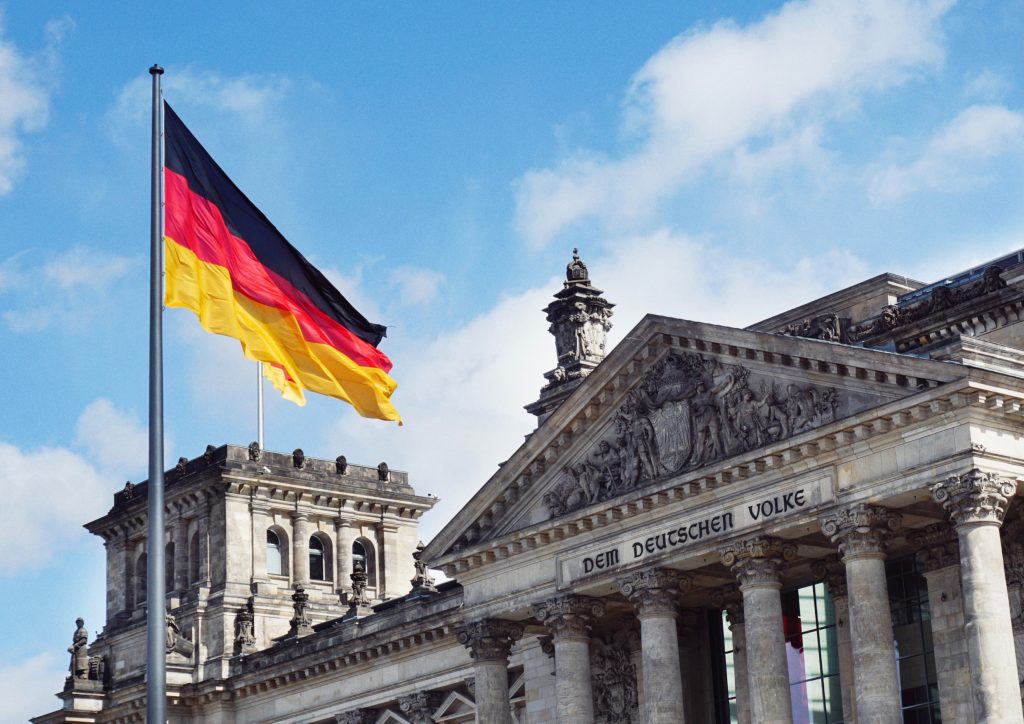
This article is about Spring Time German Vacation. Visiting Germany does not only have to be a fall event. Taking a trip to Germany in the springtime is also worth exploring!
Popular Destinations and Festivals
Germany offers a plethora of popular events and unique festivals in the springtime.
Leipzig Book Fair
The Leipzig Fair has its origins in the 15th century. The Leipzig Book Fair became the largest book fair in Germany. In 1632 when it topped the fair in Frankfurt am Main in the number of books presented, Frankfurt featured 100 books, compared to Leipzig’s 700 that year. The success and importance of the fair are linked to the emergence of a vibrant publishing industry in the city. By the 16th century, Leipzig was home to the first daily newspaper. Einkommende Zeitungen, as well as the Reclam Universal Library, Catalogs of the books included in the sale, were produced from 1594 to 1860. Throughout the 1700s and 1800s, the fair was an important event for European booksellers. And it was hosted twice yearly, occurring around Easter (Ostermesse) and St. Micheals (Michaelismesse).

1940s
It remained on top until 1945 when Leipzig became part of socialist East Germany and Frankfurt. West Germany surpassed it to regain the number one spot. During the East German era, the fair remained an important meeting place for book lovers and sellers from both East and West Germany. It provided access to Western publications for East Germans; who were not legally allowed to purchase the material but could read it at the Fair. After German Reunification, the fair moved from the Trade Fair House on the main market square to a new location removed from the city center. After the move, the fair experienced a renaissance and continues to grow today.
Leipzig and Medieval Times
Leipzig’s importance as a book fair venue is closely linked to the boom in the printing, production, and design of books that began in the Middle Ages. As early as the 16th century, the city on the River and home to the world’s first daily newspaper and Reclam Universal Library. It joined Venice, Paris, and Basel as one of Europe’s most important printing centers. Publishing houses set up shop here too, further boosting the city’s prominence.
Nevertheless, Frankfurt was initially the leading book fair city in Germany. In the 15th century, Johannes von Gutenberg invented modern book printing in Mainz. Making the neighboring Frankfurt Book Fair the first central meeting place for the book publishing trade. But Leipzig was determined to catch up to its sister to the south. It surpassed Frankfurt in the number of books exhibited for the first time in 1632. Around 1730, the Frankfurt Fair catalog had just 100 book titles, whereas the Leipzig Fair catalog featured 700.
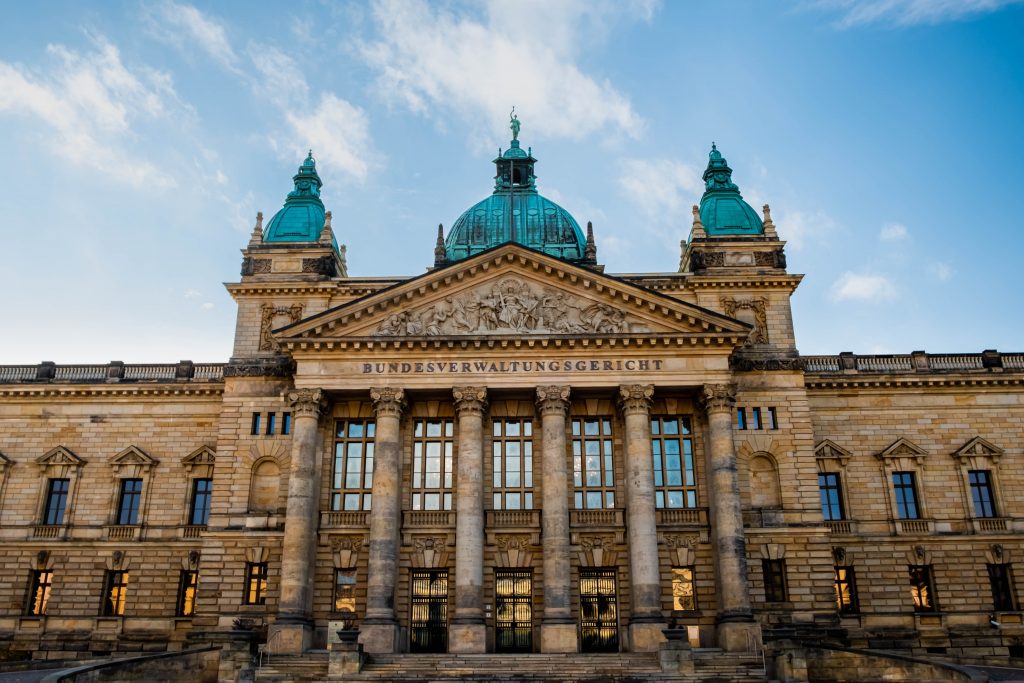
German Publishing
To better regulate the flourishing book trade, six Leipzig and 95 foreign companies founded the Börsenverein der Deutschen Buchhändler. Alsk is known as German Publishers and Booksellers Association in 1825. The association fought for copyright, against censorship, and later for fixed book prices as well. Today, as the Börsenverein des Deutschen Buchhandels, it is the German book industry’s most important interest group.
It runs the Frankfurt Book Fair and is a conceptual sponsor of the Leipzig Book Fair. The association is critical of its past. They collaborated with those in power under the National Socialist regime. Additionally, they supported the book burnings that took place around May 10thin 1933. The board also published a list of undesirable Jewish writers at the time.
Labor Day or “Maifeiertag”
The first of May is Labor Day (Tag der Arbeit). The International Workers’ Congress in Paris designated May Day as a public holiday in 1889. In 1919 the National Assembly in Weimar declared it a public holiday in Germany. It is observed by holding meetings, marches, and giving public speeches, mostly organized by trade unions. There is much more than that on May Day for sure. Ancient calendars abounded in festivals for this day.
Symbology
Many customs and symbols are connected with May Day. Maigloeckchen (Maybells) are in bloom. Houses and dance halls are decked with young green grass and flowers. People sing songs to celebrate this joyous occasion. May is the month most sung about by poets and songwriters. A part of the celebrations is ceremonial plantings of young trees. The Maypole is put up and there are dances around it. There may be a May play or a May Queen contest. In some areas, a whole village may gather around a Maypole. Everybody holds hands, dances, drinks, and is happy not to have to be at work for a day. There may be a merry procession to Maypole or dance hall; where the May Queen ceremonially declares winter defeated and opens the dance.
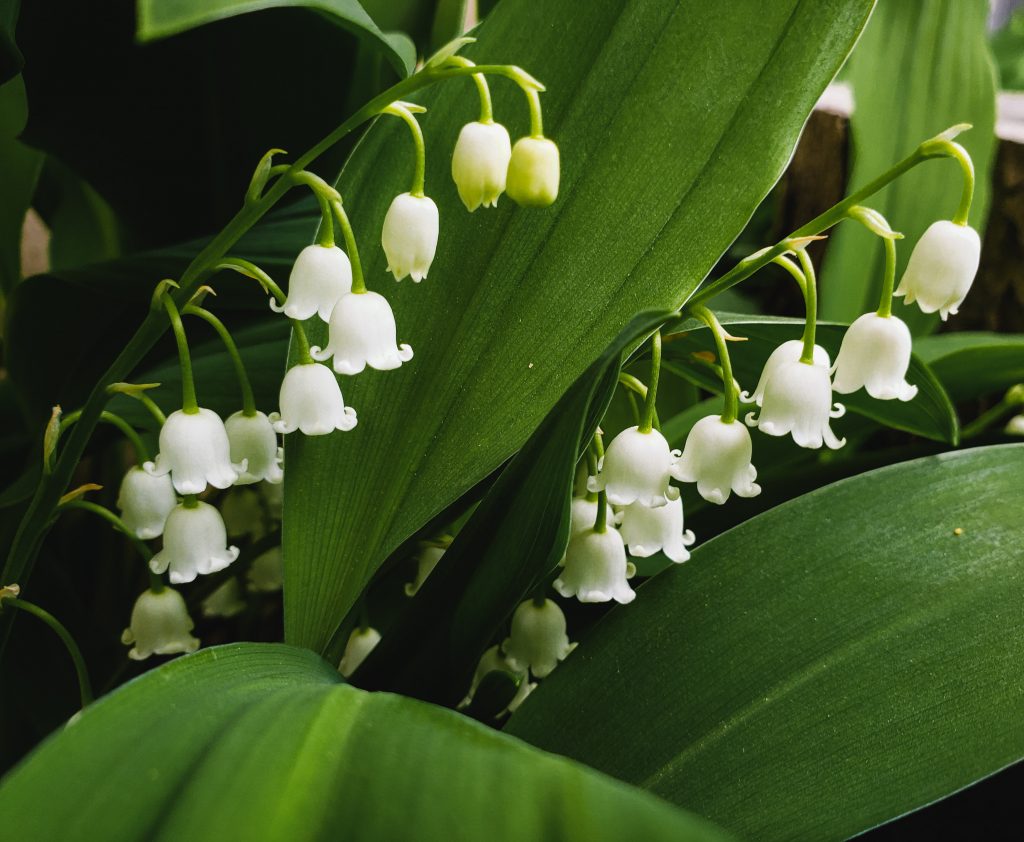
The Maypole Dance
The Maypole and the dance around it is a major symbol of spring’s reawakening of fruitfulness. May was known as the “Wonnemond,” the month of lovers where a young man’s fancy would turn to love. In May the largest number of weddings take place. Over time the Maibaum (May Tree) lost its original meaning, that of celebrating a wedding. In the old days, young unmarried men of the village would organize and sponsor parties. Dances and celebrations, to get the unmarried maidens of the village into the spirit of May. If then a wedding would take place, a tree decorated with colorful streamers and ribbons would be placed in front of the bride’s house.
Ceremonies
The traditional Maypole dance starts with long ribbons attached high up on the pole. Each dancer holds the end of a ribbon. The circle of dancers begins far out from the pole, so the ribbons are kept fairly taut. There should be an even number of dancers, facing alternatively clockwise and counterclockwise. All dancers move in the direction they are facing. Passing right shoulders with the next, and so on around to braid the ribbons over and under around the pole. Those passing on the inside will have to duck, those passing on the outside raise their ribbons to slide over.
Bavarian Traditions
In Bavaria, May 1st is an especially important day. Festivals there has a special Bavarian flavor. In Bavarian villages, it has been the custom for centuries to cut a tall and straight tree. A day or two before May 1; place it in the middle of the village and decorate it with a wreath of spring flowers and colorful ribbons. One of the traditions is to attempt to steal the Maypole of the neighboring village the night before. Hold it for ransom, usually a couple kegs of beer. At the same time, villagers had to make sure that their Maypole was not stolen by their neighbors.
Other Bavarian Traditions
Another Bavarian tradition is the Maibaumkraxeln (Maypole climbing) contest. In many parts of Bavaria; guys battle to see who can climb up the shaven and polished tree trunk the fastest. A task made even tougher by soaping down the Maypole; so that climbers only succeed if they smear ashes, tree sap, or pitch on their hands. The goal is to win the Brezeln und Wuerste. Known as, pretzels and sausages that hang on top of the pole, and to impress the girls down in the crowd. Beginners climb carefully, gradually, and in spurts. Veterans will grab a hold of the tree between hands and feet and climb right up. These are trees, 15 m (46 ft.) high, without branches, no bark, and slick as a greased pan!
Gothic Music and Culture Festival Leipzig
Wave-Gotik-Treffen (WGT) is the world’s largest Gothic music and art festival held annually in Leipzig, Germany. The date of WGT changes every year because it depends on the Catholic and Lutheran Trinity Sunday. Officially WGT starts on Friday and goes until early Tuesday morning, but in fact, the action starts on Thursday night.
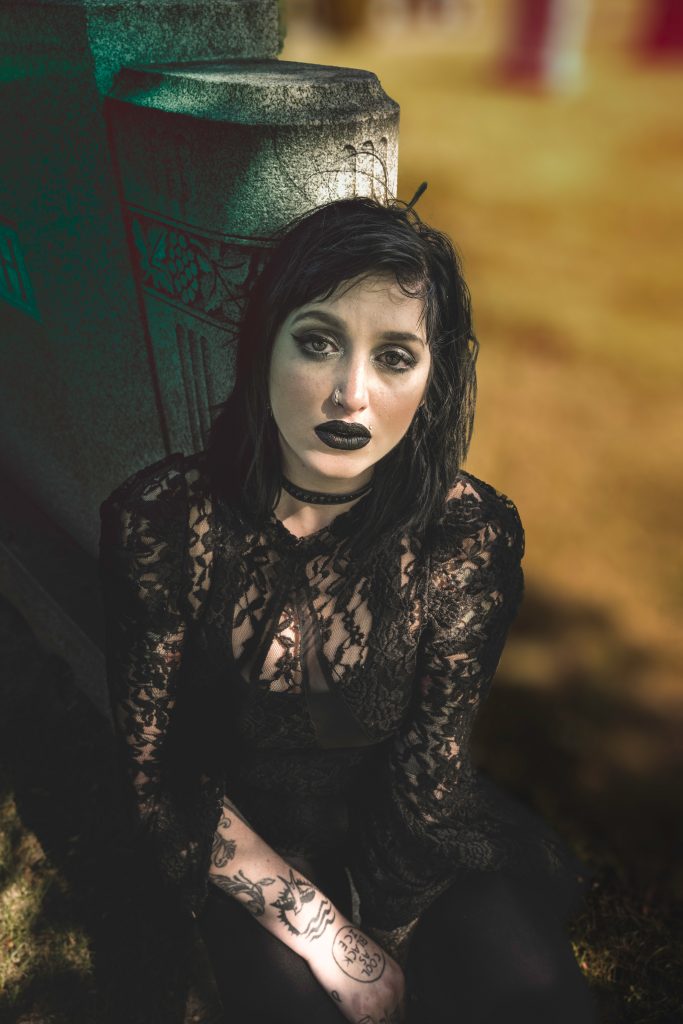
Goths from all over the world come to the festival to listen to gothic music. They participate in gothic events which cover the whole city of Leipzig for 4 days. According to unofficial estimates in recent years, this festival is attended by up to 30,000 people. It gives this festival a truly international status.
Goth Movement
The goth movement was born in England in the 1970s. This subculture is very diverse. In one way or another, it is characterized by the following features: gloomy image; the black color of clothing; interest in mysticism and decadence, and gothic music. In East Germany, a group of fans of this subculture decided to gather everyone who is close to their spirit and worldview in one place. They called this event “Wave-Gotik-Treffen” (where “treffen” means meeting). And this first attempt was made in 1987 in Potsdam. But because the festival was not legal and was illegal, only a few hundred people came. And it was not much better with gothic in Germany than in CIS countries nowadays; so the first meeting of “people in black” was dispersed.
History of the Festival
The first official festival was held in 1992 in Leipzig, in “Eiskeller” club, and it gathered about fifteen hundred people. Since then, WGT is held every year in this German city. The gathering year after year more and more fans of “dark” music from all over the world. And this event began to be approved by many famous music bands.
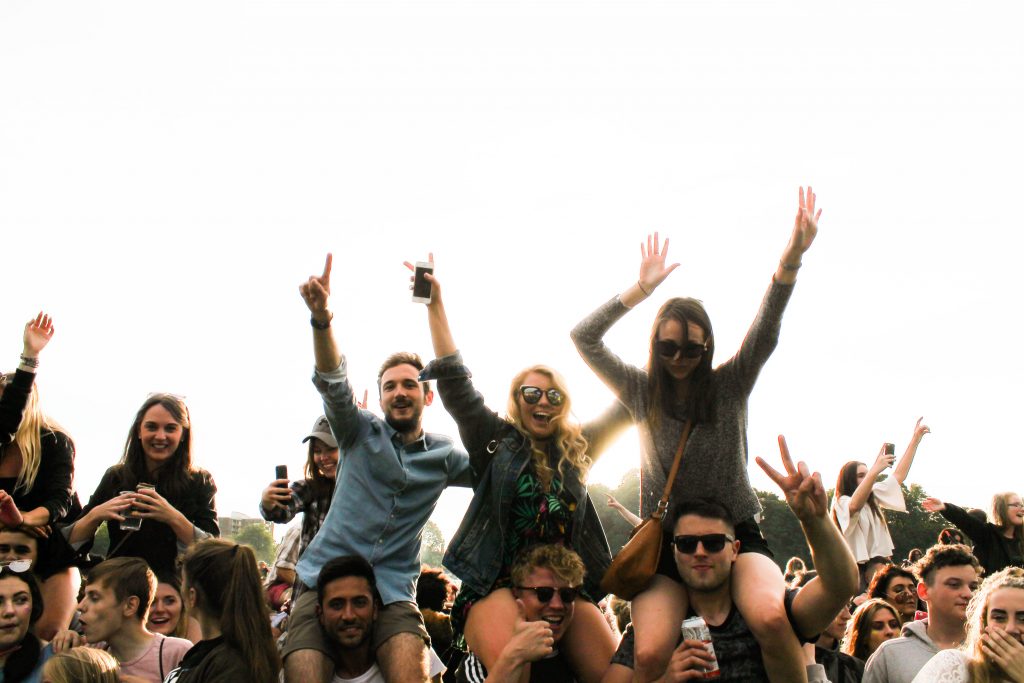
21st Century
At the beginning of the 21st century, WGT has become one of the largest events of gothic music and culture in the world. During the festival German city is filled with people in dark black robes, with metal jewelry and frightening makeup. The idea of the festival is to hold concerts on 12-15 stages in the city; where one after another performs many bands and musicians – about 200 performers in various musical genres of gothic culture. Every night there are parties with famous DJs at these venues.
Wave-Gotik-Treffen
But Wave-Gotik-Treffen is not just a music festival. Also within the framework of the festival are various staged medieval fairs; film and audio premieres; exhibitions; theatrical performances; role-playing games, and church concerts. All kinds of lectures, seminars, “tours of the oldest and most beautiful cemeteries in Leipzig” and much more. Many of the guests of the festival are middle-aged people, not just young people. Many visitors to the festival are middle-aged people, not just young people.
Since 2001 the festival is an official and large-scale event in Leipzig. It is part of the cultural program of the city’s tourism department. The city prepares for the event in advance with support, including financial, from the city government. A lot of attention is paid to safety, law and order, and cleanliness.
Festival Duration
And although for the duration of the festival, Leipzig turns into a “haven of goths”; the appearance of which is sometimes shocking: white makeup, black long hair, eerie makeup, unimaginable outfits, and accessories. But the locals have got used to this festival for a long history of its implementation; so the atmosphere in the city is full of friendliness and calmness. The more so that the Goths behave very friendly, and do not refuse requests to take a joint picture. It is also worth saying that many guests of the festival are middle-aged people, not just young people.
There are several festivals of gothic music and art on a global scale. But undoubtedly the largest and most popular is Wave-Gotik-Treffen – Festival of Gothic music and culture in Leipzig.
Spring Weather in Germany
Because if low air humidity spring comes to southern Germany later than to other countries of West Europe. March is quite cold and shifty. One day it is significantly warm and the other is suddenly cold and even snowy. Real spring begins in April with time of blossoms and the best weather starts from May. Same time this is a beginning of tourist season.
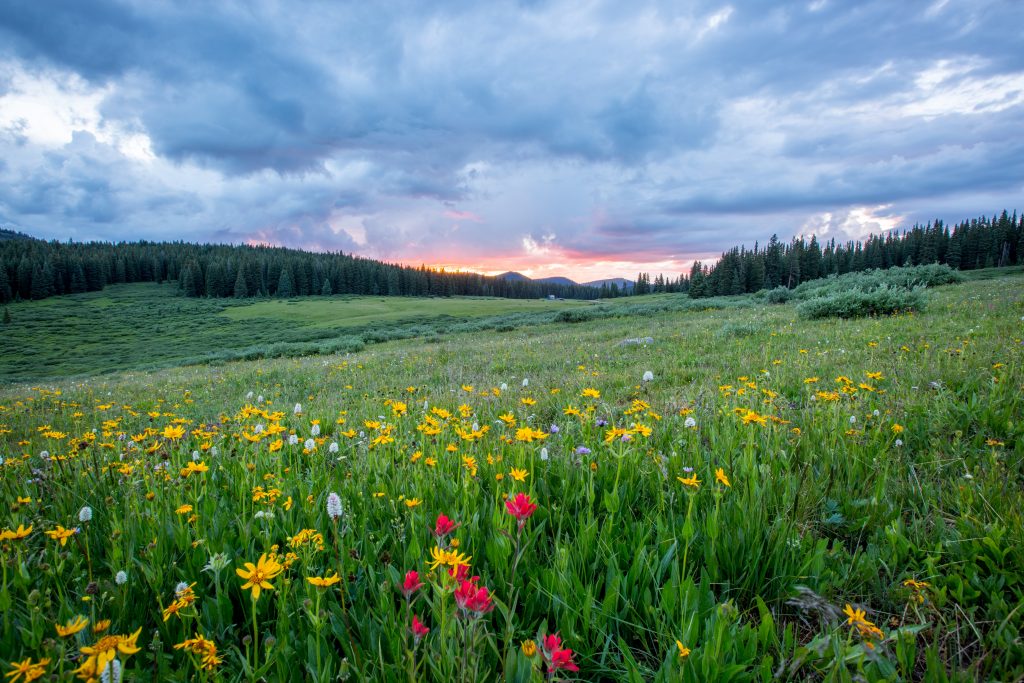
Spring is time when all German population celebrates Easter with the rest of Christian world. It is time of major fairs including The International Festival in Wiesbaden which gathers quests from the whole world. Noteworthy that May 1 celebrations of Labor Day and Spring are held in Germany as in Russia.
Other Things to Do in Germany
Brandenburg Gate
Constructed between 1788 and 1791, the Brandenburg Gate was Berlin’s first Greek revival building. Designed by Carl Gotthard Langhans, architect to the Prussian court; it was inspired by the monumental gateway at the entrance to the Acropolis in Athens. The Brandenburg Gate is 26 metres high; 65.5 metres long and 11 metres deep, and supported by two rows of six Doric columns.
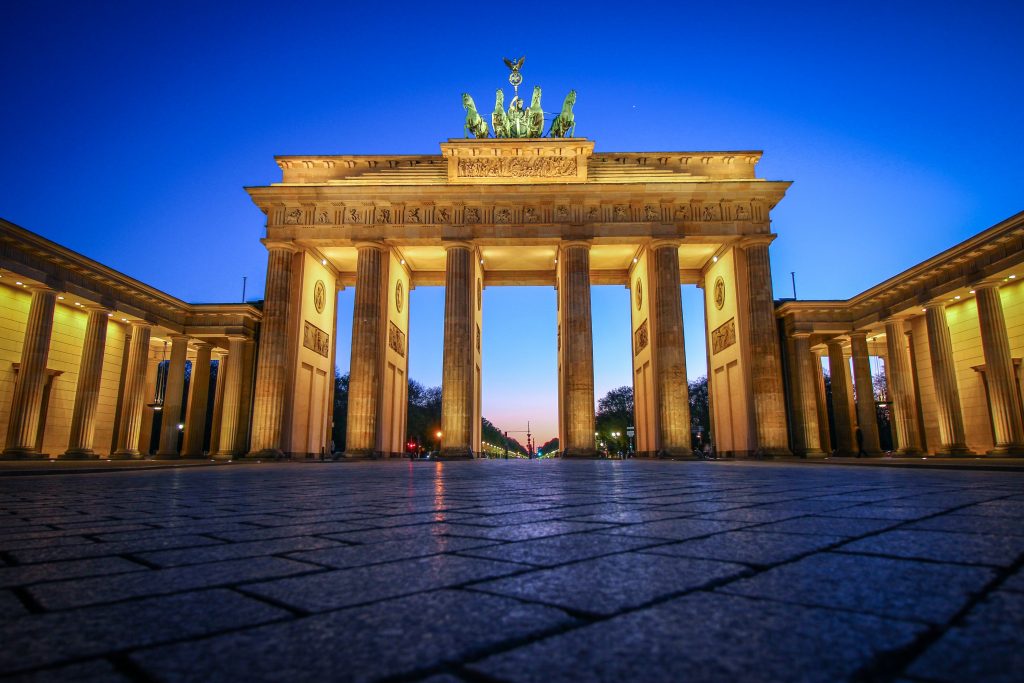
In 1793, the gate was crowned by the Quadriga statue, designed by Johann Gottfried Schadow. This statue also has its own story to tell. In 1806, when Napoleon’s army took Berlin; the French Emperor had the Quadriga transported to Paris as war booty and a sign of his victory. In 1814, after Napoleon’s forced abdication; the Quadriga was returned to Berlin where it once again adorned the Brandenburg Gate.It faced towards the east and the city centre.
Post-War
In 1946, with the post-war division of Germany and Berlin, the Brandenburg Gate was in the Soviet sector. When the Berlin Wall went up in 1961; the Gate stood in an exclusion zone in an arc of the Wall; inaccessible for locals and visitors alike. When the Wall fell, 100,000 people gathered here for the Brandenburg Gate’s official opening on 22 December 1989. Soon afterwards, crowds thronged the area to celebrate their first joint New Year’s Eve in this once-divided city. Today, more than almost any other of the city’s landmark sights, the Brandenburg Gate symbolises a reunited Berlin.
Architecture – Pariser Platz square
The Brandenburg Gate faces Pariser Platz, regarded as one of the city’s most attractive squares. By the end of the Second World War, the buildings around this historical square were in ruins. Reconstruction at this prime location only started in the 1990s after German reunification. The buildings now include elegant town houses, embassies and the impressive five-star Hotel Adlon.
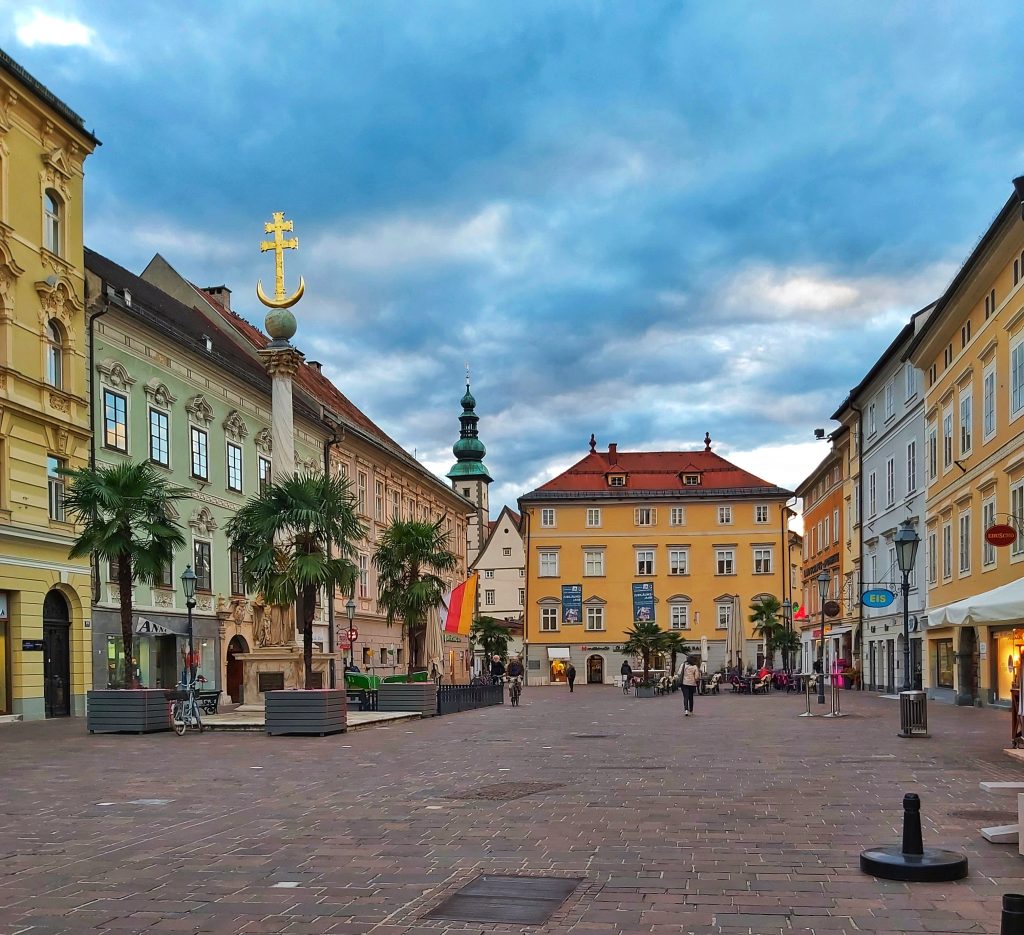
The Max Liebermann Haus and the Haus Sommer, set to the left and right of the Brandenburg Gate; were designed as a matching pair. Thus, in a style inspired by the architecture of the Prussian master builder and court architect Friedrich August Stüler. This historic location is also home to two other prominent buildings housing the embassies of France and the United States.
Berlin Tourist Info directly at the Brandenburg Gate
At the Berlin Tourist Info in the south wing of the Brandenburg Gate; you can find a wealth of information on the top sights and activities in the city . You can also book hotels or tickets for events!
Cologne Cathedral
Summary
It is regarded as the greatest expression of German Gothic architecture. Cologne Cathedral; along with Chartres Cathedral and Notre-Dame Cathedral in France . It is one of Western Europe’s most famous medieval sites of Christian art in all its majesty. Commissioned by Konrad von Hochstaden (1200-61); Archbishop of Cologne from 1238 to 1261; construction on the cathedral began in 1248, halted in 1473, and was only completed in 1880.

Popular Medieval Art
It is the largest Gothic church in Northern Europe. Furthermore, it is also Germany’s most popular monument of medieval art, receiving an average of 20,000 visitors a day. Located close to the River Rhine; the cathedral is famous for its architectural statues, steep gables, blind tracery and unifying series of spires. Moreover, its rare works of religious art, such as the sumptuous Shrine of the Three Kings (1191). The Gero Cross (960) – the oldest major carving of Christ crucified north of the Alps – and the Mailander Madonna (1290). Architecturally, the cathedral exemplifies the Rayonnant Gothic style although its design also includes some elements of extra-decorative Flamboyant Gothic architecture. In 1996, Cologne Cathedral was added to the UNESCO World Heritage List of protected sites. See also: German Gothic Art (1200-1450).
Christian buildings have stood on the site since the 4th century,. For more, see Roman Architecture and Early Christian Art. Including a square cathedral built by Maternus, the first Christian bishop of Cologne. (See Carolingian Art.) A second cathedral was completed in 818. This Ottonian Basilica was gutted by fire in 1248. While new building works were underway in preparation for a new cathedral. (See also: Ottonian Art: 900-1050.)
Origins
The origins of Colgne Cathedral dated back to 1164. At the time when the Archbishop of Cologne, Rainald of Dassel first obtained the relics of the Three Kings. Which the Holy Roman Emperor, Frederick Barbarossa, had stolen from the Basilica of Sant’Eustorgio in Milan. The relics possessed great religious significance and attracted believers from all over Christendom. As a result, church authorities determined that they required a fitting home. Hence the decision nearly 90 years later to build a new cathedral. They wanted it in the fashionable Gothic style, modelled on the French cathedral of Amiens. It seems quite probable that the patron, Archbishop Konrad von Hochstaden; a supporter of Louis IX’s anti-Swabian policies. He wanted the building to reflect the formal elegance of the structures going up in Paris at the time. For example, the Sainte Chapelle (1241-48).
Final Touches
The cornerstone was duly laid in August 1248, by Archbishop Konrad von Hochstaden. Construction proceeded under the direction of architect Master Gerhard and later Master Michael. Although consecrated in 1322 work on the West facade halted in 1473. During the highpoint of the celebrated Cologne School of painting. This left the south tower complete up to belfry level. A large crane remained in situ scarring the Cologne skyline for 400 years, until work resumed in 1842. At this point modern building methods; including the use of iron roof girders were incorporated into the construction plan. It was completed (more or less) in 1880. It’s two huge spires. At roughly 157 metres (515 ft) tall, the second-tallest after Ulm Minster. This gave it the largest facade of any church in the world.
Architecture of Cologne Cathedral
The cathedral is 144.5 meters (474 ft) in length; 84 meters (275 ft) wide. It has a window surface area of 10,000 square meters (108,000 sq ft). This is roughly three times more stained glass art than Chartres. Rayonnant forms of Gothic art spread rapidly across the borders of France.
They were quickly adopted in the leading commercial cities. Cologne, like its contemporary Strasbourg, became one of the principal centers for the elaboration of Rayonnant Gothic. So much so that, unlike the majority of similar German buildings, it is difficult to recognize any holdovers of the Germanic tradition.
Layout
The plan of the cathedral is in the shape of a Latin Cross. It has two aisles on either side. A feature is taken from Paris or Bourges. This supports one of the highest Gothic vaults ever built, being almost as tall as that of Beauvais Cathedral, which collapsed in 1284. The general design of the building repeats that of the cathedral of Amiens, but not without variations.
More Details
The presence of a deep network. This shortens the nave and creates a feeling of centrality. It is perhaps a holdover of local traditions. The medieval choir has a very tall arcade and a narrow triforium gallery. It is detailed tracery lit by windows. While the clerestory windows are tall with some of the original stained glass in the lower sections. The vault is composed of a plain quadripartite arrangement.
Modern Influence
The ‘modern’ aspects of Cologne are its abandonment of the engaged column derived from Chartres. This was done to adopt instead a clustered arcade pier. A group of shafts that rise straight up without interruption to the springers of the vaults. Its luminous glazed triforium.
Similar to an elegant work of filigree. All thanks to the elimination of the small arches from the pendentives. Externally the outward and downward thrust of the vault is absorbed and channeled by flying buttresses in the French manner. Indeed its exterior is famous for its extravagant use of tracery, flying buttresses, stone sculpture, pinnacles, and lofty porticos.
A major treasure of the cathedral is its High Altar, installed in 1322. Made out of black marble, with a single slab 4.6 meters (15 ft) in length forming the top. Its front and side surfaces are faced with white marble niches decorated with relief sculptures. Illustrating religious scenes such as the Coronation of the Virgin, a popular Gothic motif.
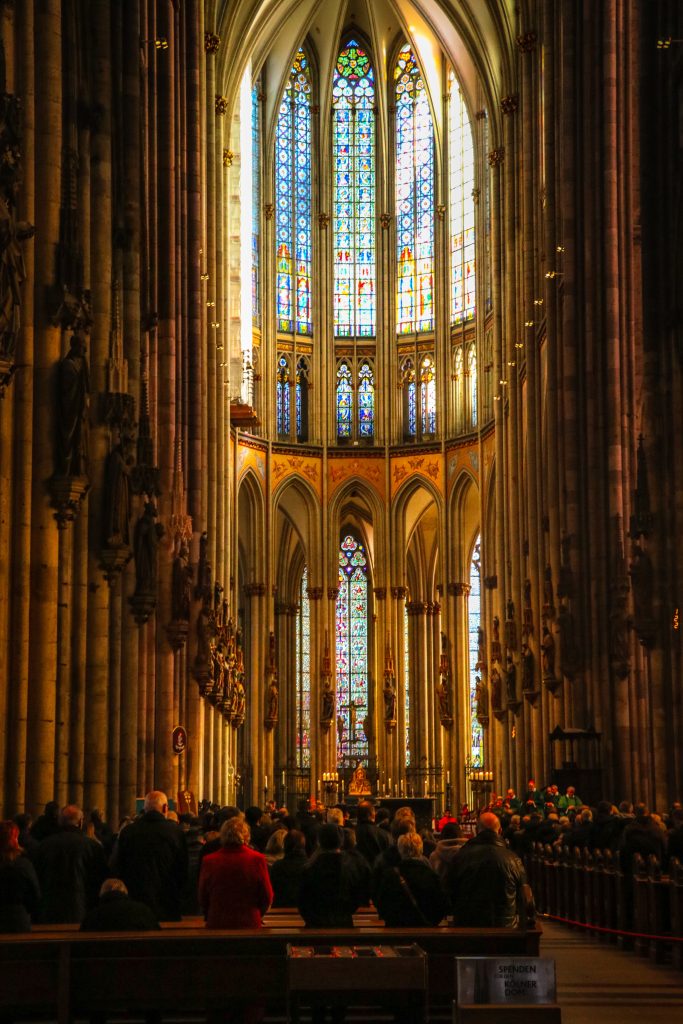
The most significant work of art in Cologne is the Shrine of the Three Kings(1191). A large gilt sarcophagus in the shape of a basilican church. Located behind the high altar, it was commissioned by Philip von Heinsberg, Archbishop of Cologne (1167-1191).
It was created by Nicholas of Verdun (c.1156–1232). A superb example of medieval goldsmithing and Romanesque sculpture. It is reputed to be the largest reliquary in the western world. Supposedly it contains the remains of the Three Wise Men. Allegedly, his relics were seized by Frederick Barbarossa during his conquest of Milan in 1164.
Other Works of Art
Near the sacristy is the Gero Cross (965–70) a large wood carving of the crucified Christ, originally gilded and painted. Created about 960 for Archbishop Gero (900-976). Archbishop of Cologne (969-976); this exquisite piece of Biblical art is believed to be the earliest-known large-scale crucifix north of the Alps. Located in the Sacrament Chapel, is the wooden Mailander Madonna (1290). An example of Marian Gothic sculpture depicting the Virgin Mary and the infant Jesus.
The most controversial work of art in the cathedral is probably the huge 113-square-meter stained glass window; created by the postmodernist German artist Gerhard Richter (b.1932). Consisting of 11,500 identically sized pieces of colored glass.
Arranged at random by computer, it triggered a protest from the archbishop of the cathedral Cardinal Joachim Meisner (b.1933). He favored a more appropriate figurative depiction of 20th-century Catholic martyrs. See also: Stained Glass: Materials & Methods.
The Berlin Wall
Berlin was a divided city for nearly thirty years – a city with a wall running through its very heart. From 13 August 1961 until 9 November 1989, the Berlin Wall divided the city into East and West Berlin.
Today, all across the city you can find traces of the Wall. Its remains and memorial sites – the East Side Galler; the Berlin Wall Memorial in Bernauer Strasse. The Berlin-Hohenschönhausen Memorial, a former Stasi remand prison; and the green Mauerpark. But the remains of the Berlin Wall can also be found in more remote places in Berlin-Spandau; in Berlin-Reinickendorf or at the Cathedral Cemetery.

The route of the Berlin Wall is even marked along some of Berlin’s streets by a double row of cobblestones. The Berlin Wall Cycle Route also offers a great way to trace the route of the Wall by bike. The route crosses the city following the path of the Berlin Wall. The entire cycle route covers over 160 kilometers along the former GDR border encircling West Berlin.
The Eastside Gallery
The East Side Gallery is the longest surviving section of the Berlin Wall. In 1990, more than 100 artists from over 20 countries; decorated this stretch of the hinterland wall with their artworks. The most famous is undoubtedly the work known as “Fraternal Kiss”. It depicts a kiss between Russian leader Leonid Brezhnev and East Germany’s SED Party Chairman Erich Honecker.
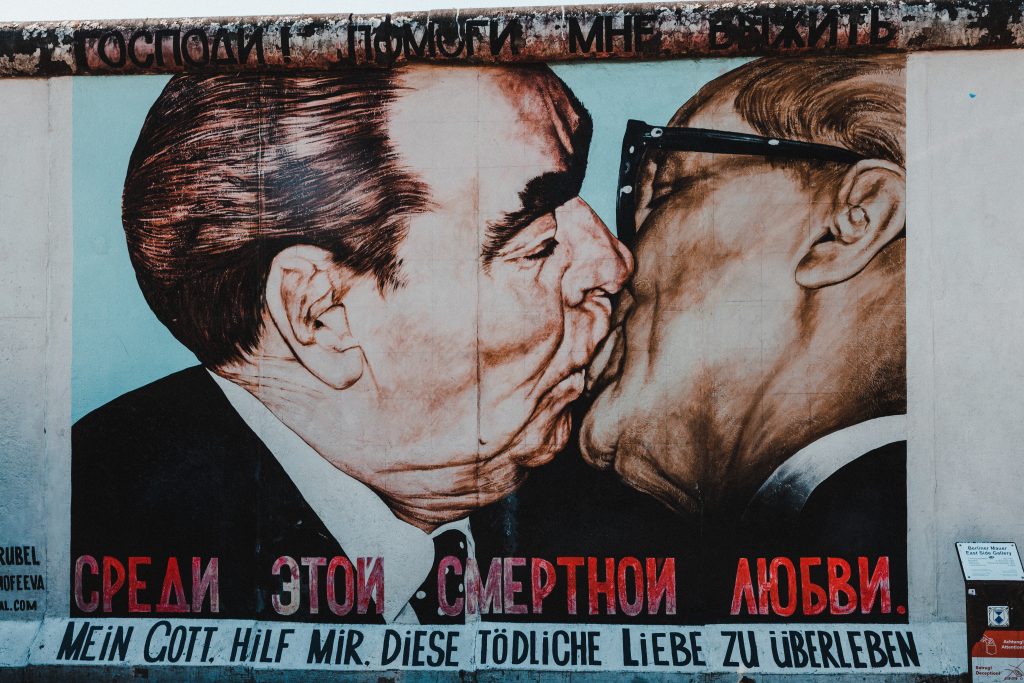
You can find lots of information and pictures about the East Side Gallery and the Berlin Wall in museums and exhibitions. Visit The Wall Museum East Side Gallery or the Museum Die Mauer I The Wall. You can also find interactive productions on revolution. Free space and borders in the exhibition Berlin Global at the Humboldt Forum.
More On The History of the Wall
The construction of the Berlin Wall did stop the flood of refugees from East to West. It did defuse the crisis over Berlin. Though he was not happy about it, President John F. Kennedy conceded that “a wall is a hell of a lot better than a war.” Almost two years after the Berlin Wall was erected, John F. Kennedy delivered one of the most famous addresses of his presidency.
In front of a crowd of more than 120,000 gathered outside West Berlin’s city hall; just steps from the Brandenburg Gate. Kennedy’s speech has been largely remembered for one particular phrase. “I am a Berliner.”
In all, at least 171 people were killed trying to get over, under, or around the Berlin Wall. Escape from East Germany was not impossible. However, from 1961 until the wall came down in 1989, more than 5,000 East Germans; including some 600 border guards; managed to cross the border. Either by jumping out of windows adjacent to the wall; climbing over the barbed wire; flying in hot air balloons; crawling through the sewers and driving through unfortified parts of the wall at high speeds.
The End of the Cold War
On November 9, 1989, the Cold War began to thaw across Eastern Europe. The spokesman for East Berlin’s Communist Party announced a change in his city’s relations with the West. Starting at midnight that day, he said, citizens of the GDR were free to cross the country’s borders. East and West Berliners flocked to the wall, drinking beer and champagne and chanting “Tor auf!” (“Open the gate!”). At midnight, they flooded through the checkpoints.
Visitors
More than 2 million people from East Berlin visited West Berlin that weekend to participate in a celebration. That was, one journalist wrote, “the greatest street party in the history of the world”. People used hammers and picks to knock away chunks of the wall.
They became known as “mauerspechte,” or “wall woodpeckers”. All while cranes and bulldozers pulled down section after section. Soon the wall was gone and Berlin was united for the first time since 1945. “Only today,” one Berliner spray-painted on a piece of the wall, “is the war really over”. The reunification of East and West Germany was made official on October 3, 1990. Almost one year after the fall of the Berlin Wall.
The Black Forest
The Black Forest region in southwest Germany attracts thousands of visitors each year.
It might be on a tour bus, with stops to view the largest cuckoo clock in the world or sample a slice of the famous Black Forest cake. Or visitors could be attracted by the outdoor activities: taking to the hiking trails that criss-cross the Black Forest area or sampling some of the skiing and snowshoe walking in the winter months.
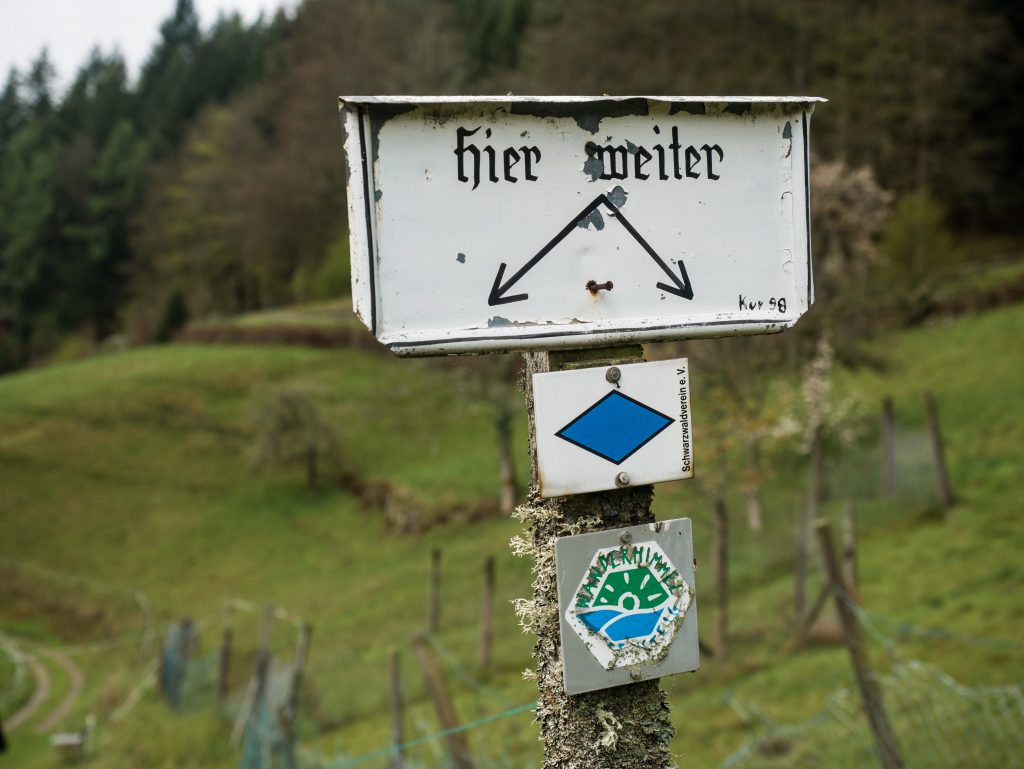
It could be just the attraction of a small town in a location such as the Kinzig valley or along the Rhine valley near the Swiss border. Somewhere where local traditions can still be experienced in an authentic Black Forest lifestyle.
Black Forest Germany offers a chance to explore some of the locations and activities that might help the visitor to decide on a break in this part of southern Germany.
Destinations in the Black Forest Region
Those visitors looking to stay in the Black Forest area have a choice of larger towns and cities with plenty of to do on the edge of the region and good access to the sights and activities or the smaller towns and villages at the heart of the Black Forest at the sights themselves and with access to the outdoors from the doorstep. Over on the western edge of the Black Forest, Freiburg im Breisgau is a good choice for those searching for somewhere livelier. It is a young city with plenty going on, but still with great access into the southern Black Forest.
Western Flank
Keeping on the western side, the spa town of Baden-Baden is another good option, with its proximity to the Black Forest National Park.On the other side of the Black Forest, the town of Donaueschingen offers great rail links across the region to Freiburg on the Höllentalbahn and north on the Black Forest railway to Offenburg and Karlsruhe. It is also the start of the Danube valley rail link through to Ulm for those looking to combine exploration of the Black Forest with the upper stages of the famous river.
The Kinzing Valley and Other Locations
Those who would prefer to be close at hand to the famous sights of the region could choose from Titisee, with its scenic lake and mountain hikes and access to rail links, or maybe Triberg, where Germany’s highest waterfall attracts thousands of daily visitors in high summer.
The Kinzig valley offers a variety of small settlements each with their own attractions, like the Schwarzwälder Trachtenmuseum (‘Museum of Traditional Costumes in the Black Forest‘) in the small town of Haslach.
And those looking for an old town to wander around might like to try the timber-framed houses of Calw in the northern Black Forest, the town where famous author Herman Hesse was born and grew up.
Freudenstadt is another centrally-located back in the northern part of the region with good access to hiking routes.
Outdoor Activities in the Black Forest
Summer in the Black Forest is a perfect time for anyone who is keen on hiking. There are numerous long-distance trails through the region lasting well over a week, as well a good choice of day hikes in places such as Freudenstadt, the National Park area and further south around Titisee and the Wutach valley.
Winter offers even more of a choice when it comes to outdoor sports. Many of the shorter hiking trails are available as snowshoe walks when snow conditions permit, while there are plenty of smaller downhill and cross-country ski areas.
Travel to and in the Black Forest
Travel around the Black Forest is relatively easy no matter if it is by private car or public transport. The region benefits from excellent links on the German Autobahn (‘motorway’) system. Basel, Freiburg, Karlsruhe and Stuttgart are all linked by the high-speed road network and another route heads south from Stuttgart just off to the east of the area linking up with access points to Lake Constance and Switzerland.
Other Travel Options
The Black Forest has five airports within easy reach – so travellers from further away should have no problem finding a flight option. The option of arriving by train also benefits from a good rail network, not only around the outskirts of the region but through it as well. The Black Forest train routes include the Schwardwaldbahn going through the central and northern section, the Höllentalbahn linking east and west across the southern Black Forest and some scenic shorter routes.
Mercedes-Benz Factory
The Mercedes-Benz Museum documents the history of one of the world’s most famous automobiles, displaying over 130 years of auto industry history. Spanning nine levels throughout a floor space of over 16,500 square meters, the museum is home to more than 1,500 exhibits with 160 vehicles, ranging from the SLK to the E-Class Coupé.

The museum offers a behind-the-scenes look at one of Germany’s most modern car factories and witnesses the production of the SL, SLK, C-Class, E-Class Coupé, and the GLK cars close at hand. A variety of guided tours through the various sections of the factory are also offered, including automobile, architectural, and electronic guided tours.
Mannheim Palace
Mannheim Palace is a large Baroque palace, originally the main residence of the Prince-electors of the Electorate of the Palatinate of the House of Wittelsbach. It is now primarily used by the University of Mannheim. The city of Mannheim, founded in 1606, was fortified and at the present site of the castle, there was a fortress called Friedrichsburg, sometimes serving as an alternative residence for the Elector, one of the most important territorial princes of the Holy Roman Empire.
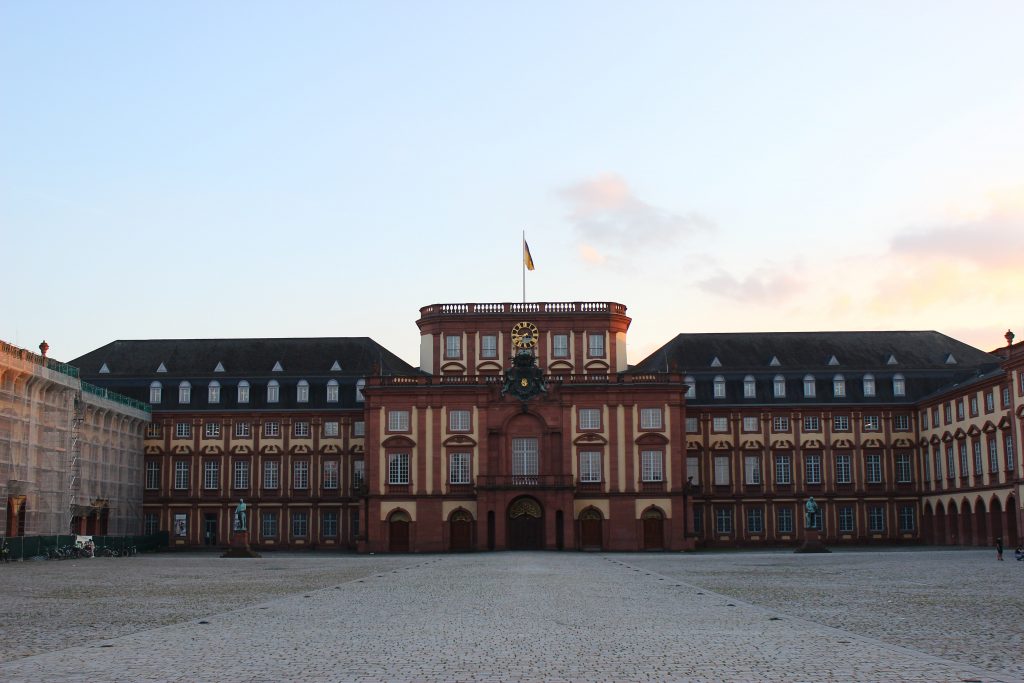
The actual palace dates from the 18th century. When Elector Karl III Philip had confessional controversies with the inhabitants of his capital Heidelberg, he decided to make Mannheim the Palatinate’s new capital in 1720. Karl Philip decided to construct a new palace as his residence on the site of the old Friedrichsburg. It was part of a general trend among the German princes to create grand new residences in that era.
Construction
Construction was commenced solemnly on June 2, 1720. The building process was intended to cost about 300,000 Gulden, financed by an extraordinary “palace tax”, but in the end, the palace cost about 2 million Gulden and severely worsened the Palatinate’s financial situation. The first administrative institutions began using the palace in 1725, but Karl Philip was able to transfer his court to the new residence only in 1731. Construction was not completed until 1760.
Karl Philip died in 1742 and was succeeded by a distant relative, the young Karl Theodor. During his reign, the palace and the city of Mannheim saw their zenith. The glamour of the Elector’s court and Mannheim’s then-famous cultural life lasted until 1778 when Karl Theodor became Elector of Bavaria by inheritance and he moved his court to Munich. Although Mannheim kept the title of “residence”, the palace was used merely as accommodation for several administrative bodies.
War and Reconstruction
Things worsened further during the Napoleonic Wars when Mannheim was besieged. During Napoleon’s reorganization of Germany, the Electorate of the Palatinate was split up and Mannheim became part of the Grand Duchy of Baden, thus losing its capital/residence status.
Some glamour returned to Mannheim Palace when Stéphanie de Beauharnais, the consort of Grand Duke Karl of Baden, resided here after 1806. For most of the 19th and early 20th centuries, the palace served no uniform purpose, being used as a representative building and a museum for the city.
In World War II, the palace was heavily bombed and partly destroyed. Many people supported demolishing it after the war to create space for a more modern city architecture. These plans came to nothing and the palace was reconstructed.
Heidelberg Castle
Heidelberg Castle (German: Heidelberger Schloss) is a ruin in Germany and a landmark of Heidelberg. The castle ruins are among the most important Renaissance structures north of the Alps.
The castle has only been partially rebuilt since its demolition in the 17th and 18th centuries. It is located 80 meters (260 ft) up the northern part of the Königstuhl hillside and thereby dominates the view of the old downtown. It is served by an intermediate station on the Heidelberger Bergbahn funicular railway that runs from Heidelberg’s Kornmarkt to the summit of the Königstuhl.
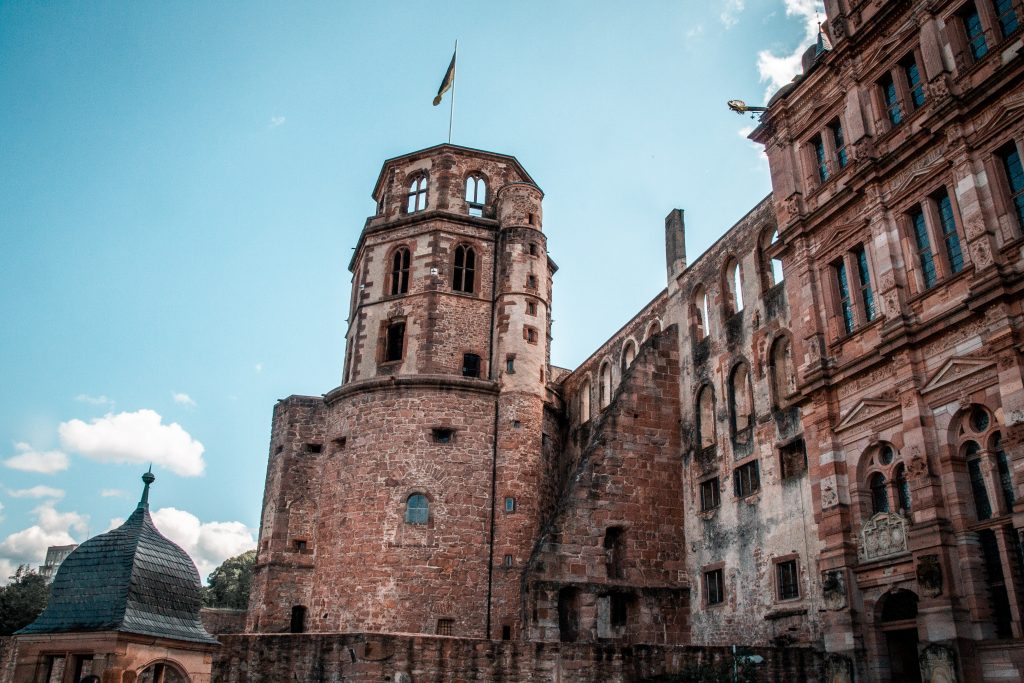
The earliest castle structure was built before 1214 and later expanded into two castles circa 1294; however, in 1537, a lightning bolt destroyed the upper castle. The present structures had been expanded by 1650, before damage by later wars and fires. In 1764, another lightning bolt caused a fire that destroyed some rebuilt sections.
Slow decay and Romantic enthusiasm
The ruins of the castle as portrayed in an 1815 painting by Karl Philipp Fohr. In 1777, Karl Theodor became ruler of Bavaria in addition to the Palatinate and removed his court from Mannheim to Munich. Heidelberg Castle receded even further from his thoughts and the rooms which still had roofs were taken over by craftsmen. Even as early as 1767, the south wall was quarried for stone to build Schwetzingen Castle. In 1784, the vaults in the Ottoheinrich wing were filled in, and the castle was used as a source of building materials.
Post German Mediatisation
As a result of the German mediatization of 1803, Heidelberg and Mannheim became part of Baden. Charles Frederick, Grand Duke of Baden welcomed the addition to his territory, although he regarded Heidelberg Castle as an unwanted addition. The structure was decaying and the townsfolk were helping themselves to stone, wood, and iron from the castle to build their own houses.
The statuary and ornaments were also fair game. August von Kotzebue expressed his indignation in 1803 at the government of Baden’s intention to pull down the ruins. At the beginning of the nineteenth century, the ruined castle had become a symbol of the patriotic movement against Napoleon.
1800s
Even before 1800, artists had come to see the river, the hills, and the ruins of the castle as an ideal ensemble. The best depictions are those of England’s J. M. W. Turner, who stayed in Heidelberg several times between 1817 and 1844, and painted Heidelberg and the castle many times.
He and his fellow Romantic painters were not interested in faithful portrayals of the building and gave artistic license free rein. For example, Turner’s paintings of the castle show it perched far higher up on the hill than it actually is.
Promoting Castle Grounds
The savior of the castle was the French count Charles de Graimberg. He fought the government of Baden, which viewed the castle as an “old ruin with a multitude of tasteless, crumbling ornaments”, for the preservation of the building. Until 1822, he served as a voluntary castle warden and lived for a while in the Glass Wing (Gläserner Saalbau), where he could keep an eye on the courtyard.
Long before the origin of historic preservation in Germany, he was the first person to take an interest in the conservation and documentation of the castle, which may never have occurred to any of the Romantics. Graimberg asked Thomas A. Leger to prepare the first castle guide. With his pictures of the castle, of which many copies were produced, Graimberg promoted the castle ruins and drew many tourists to the town.
Neuschwanstein Castle
Ludwig II, King of Bavaria since 1864, addressed the following lines to the man he so greatly admired, Richard Wagner:
Quote:
“It is my intention to rebuild the old castle ruin of Hohenschwangau near the Pöllat Gorge in the authentic style of the old German knights’ castles, and I must confess to you that I am looking forward very much to living there one day (in 3 years).
There will be several cozy, habitable guest rooms with a splendid view of the noble Säuling, the mountains of Tyrol, and far across the plain; you know the revered guest I would like to accommodate there; the location is one of the most beautiful to be found, holy and unapproachable, a worthy temple for the divine friend who has brought salvation and true blessing to the world.
It will also remind you of “Tannhäuser” (Singers’ Hall with a view of the castle in the background), “Lohengrin'” (castle courtyard, open corridor, path to the chapel); this castle will be in every way more beautiful and habitable than Hohenschwangau further down, which is desecrated every year by the prose of my mother; they will take revenge, the desecrated gods, and come to live with Us on the lofty heights, breathing the air of heaven.”
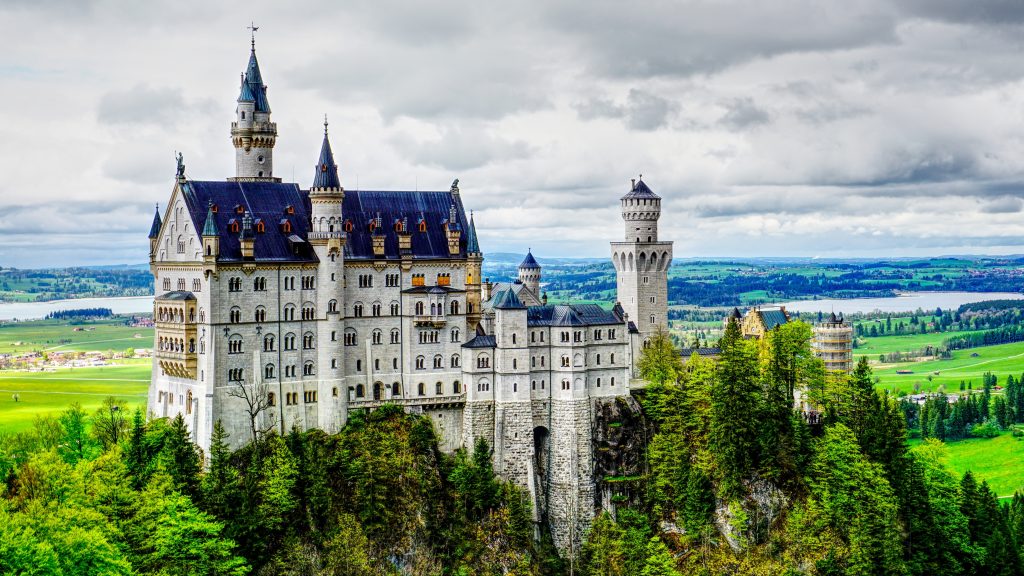
The Reasons for Building
Almost all the aspects of Ludwig’s Neuschwanstein are mentioned here. What is not mentioned, however, is the political reason for building: in 1866 Bavaria, allied with Austria, had lost a war against the expanding Prussia. Bavaria was forced to accept a “defensive and offensive alliance”, which removed the king’s right to dispose of his army in case of war.
From 1866, therefore, Ludwig II was no longer a sovereign ruler. This limitation was the biggest misfortune of his life. In 1867 he began planning his own kingdom, in the form of his castles and palaces, where he could be a real king.
The Inner Workings of the Castle
The castle was not built as rapidly as the king expected. The project was too comprehensive and the building site on the mountain presented difficulties. Set designers, architects, and artisans implemented the king’s detailed ideas.
The inconsiderate deadlines he set could sometimes only be met by working day and night. The foundation stone of the “New Castle” was laid on 5 September 1869. The Gateway Building was constructed first, and Ludwig II lived here for a number of years. The topping-out ceremony for the Palas was not until 1880, and the king moved in in 1884.
Withdrawal of the King
As he increasingly withdrew from human contact and focused even more on his royal dignity, Ludwig II changed the building program. The guest rooms were replaced in the plans by a “Moorish Hall” with a fountain, but this was never actually built. The “Writing Room” was changed in 1880 into a small grotto. The modest “Audience Room” became a huge Throne Room.
This was no longer intended for giving audiences but was built as a monument to kingship and a copy of the legendary Grail hall. Highly modern steel construction was necessary in order to incorporate this hall in the Palas, which was already standing.
A “knights’ bath” was to be installed in the west part of the Palas, reminiscent of the ritual bath of the knights of the Holy Grail. Today there is a flight of stairs here for use by visitors, which leads down to the exit
The Rhine Valley
The Middle Rhine was the heart of the medieval Holy Roman Empire and the region was a magnet for great artistry, ingenuity, and craftsmanship. During its heyday, it was one of the most important trading areas in Europe—arguably, the world. Journey through the Romantic Rhine Valley and discover the culture, the stories, the gastronomy, and the wine that makes this one of Europe’s most renowned romantic landscapes.
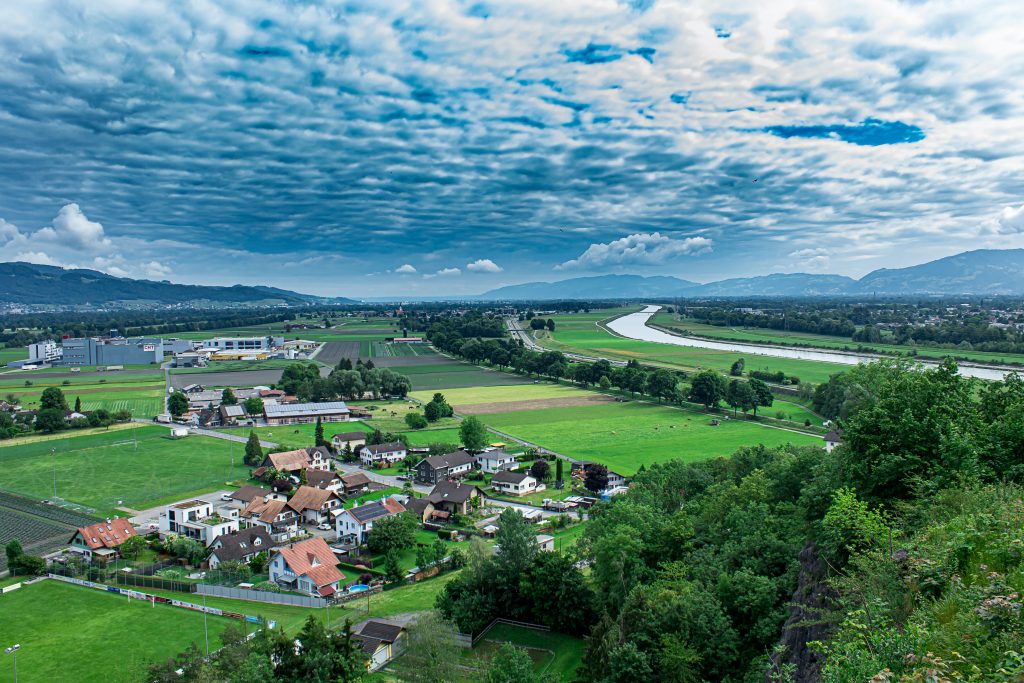
Imbued with the spirit of German Romanticism, the Rhine River has inspired fairy tales, fables, poetry, and paintings. Its mythical underwater maidens and their magic gold provided the muse for Wagner’s “Ring” opera cycle. The evocative voyage from Mainz to Koblenz has been a favorite with travelers since the 19th century.
The stretch from Bingen, west of Mainz, runs through a steep and narrow gorge and has more castles than any other river in the world. Below these cliff-top fortresses sit villages of half-timbered houses, like the settlement of Bacharach, which owes their existence to the Riesling grape grown along the hillsides.
Creative Energy in Nature
The reason for all this creative energy in one place is simple. The Rhine has been an important transportation link between the north and south of Europe for thousands of years. This led to an exchange of culture and a flow of trade, which helped build small towns and impressive fortresses along the river’s course. It is no wonder this natural beauty and historic architecture have fueled artists, writers, and musicians over the past two centuries.
As the epochs changed, at the beginning of the 19th century, a new generation of artists—from the early Romantic period—discovered a beauty in the Rhine’s wild cultural landscape. The river started to appear in German literature. Within 20 years, English Romantic artists like JMW Turner and writers like Lord Byron brought international fame to the Rhine and breathed new life into the valley.
Upper Middle Right
The Upper Middle Rhine Valley stretches for 67 kilometers, down a gently winding stretch of the river. Starting at Bingen, you can travel by boat, car, bicycle, or foot, with panoramic views along the whole route. The castles stand high on the hills and many of them are open to the public. Shoreside hamlets offer plenty of opportunities for rest and exploration.
People come from across the world to see the striking Loreley Rock, near the town of Sankt Goarshausen, which is a symbol of Rhine Romanticism and the subject of well-known poems and songs. At the end of the valley, the beautiful city of Koblenz has a cable car that can take you across the water and up to the Ehrenbreitstein Fortress.
US Troops in Germany
The Federal Republic of Germany has been a vital part of the United States defense strategy in Europe ever since the end of World War II when US forces were part of a 10-year Allied occupation of the country. Though troop numbers have fallen drastically since those days, the US military still maintains a major presence and over the intervening decades, US military communities have formed around a handful of German towns.
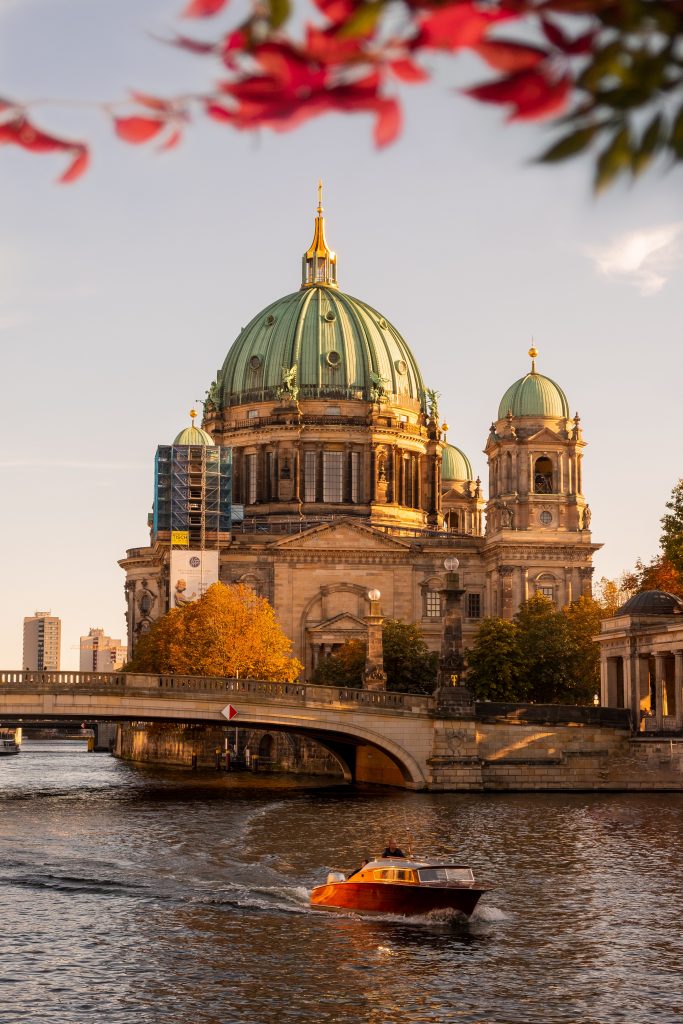
Germany’s strategic importance for the US is reflected by the location of the US European Command. EUCOM headquarters is in the southwestern city of Stuttgart, from which it serves as the coordinating structure for all American military forces across 51 primarily European countries.
EUCOM Mission
The mission of EUCOM is to protect and defend the US by deterring conflict. Supporting partnerships such as NATO and countering transnational threats. At its command are the US Army Europe, the US Air Forces in Europe, and the US Marine Corps Forces Europe and Africa. All of which have installations in Germany.
In fact, Germany hosts the largest portion of US troops in Europe. Roughly 38,600, though the numbers vary as troops are regularly rotated to other countries. This is also more military personnel than the US keeps in any other country except Japan.
However, the numbers have fallen in recent years. German government figures show that between 2006 and 2018, the number of US troops stationed in Germany more than halved. From 72,400 to 33,250, as the US military responded to a shifting and increasingly complex global security situation.
Marines, Soldiers, and Airmen
Germany is home to five of the seven US Army garrisons in Europe. The other two are in Belgium and Italy. The US Army Europe is headquartered at the garrison in Wiesbaden, a city close to Frankfurt in central western Germany.
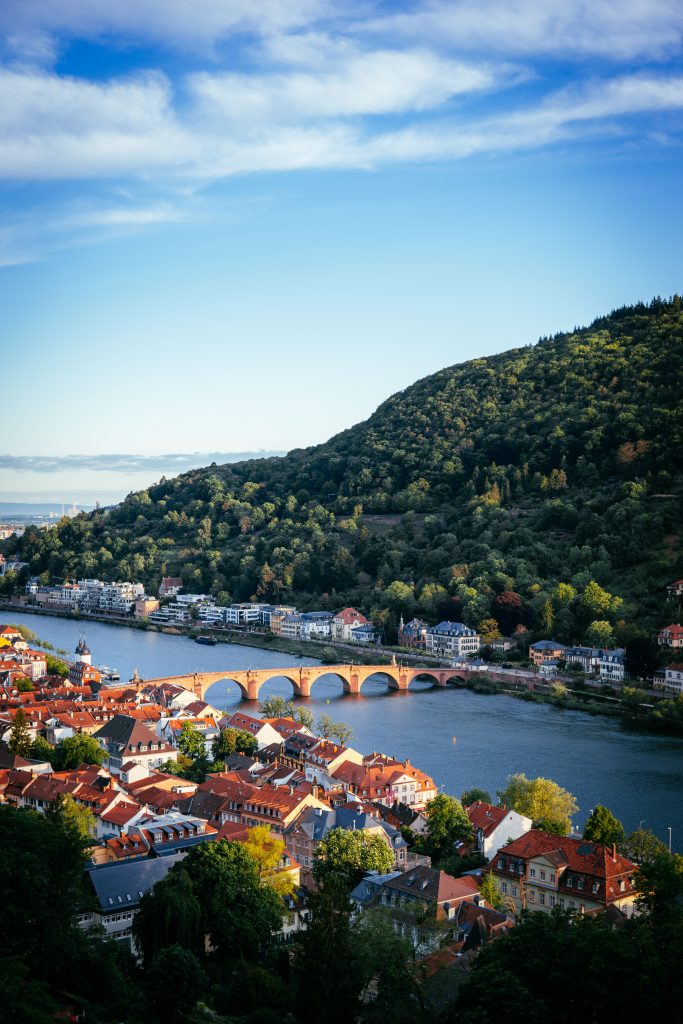
Figures provided to DW by the US military show that these five garrisons, each consisting of various installations at different locations, currently comprise around 29,000 military personnel. This number includes the US Marine Corps Forces of Europe and Africa, which are headquartered in Böblingen. Southwestern Germany, as part of the US Army Garrison Stuttgart. In addition, roughly 9,600 US Air Force personnel are spread across various locations in Germany. Including the two US Air Force bases of Ramstein and Spangdahlem.
US military in Germany: More than troops
Because US military installations also employ American civilians, and servicemen and women can sometimes bring their families with them overseas, sizable civilian communities can form around bases. In fact, some US bases in Germany, such as the one near Ramstein, are small towns in themselves. They include not only barracks, airfields, exercise terrain, and material depots; but also their own American shopping malls, schools, postal services, and police force. Sometimes the only legal tender is the US dollar.
Meanwhile, the US Army Bavaria Garrison, headquartered at Grafenwöhr, near Bavaria’s border with the Czech Republic, is the largest overseas US Army base in the world. Both in population and acreage, covering over 97,000 acres (390 square kilometers).
Effects on Local Economies
Bases also often employ significant numbers of local nationals and serve as an economic boost for the surrounding German communities. Whose businesses provide goods and services. Past installation closures, such as the army garrison at Bamberg in 2014, took a toll on the local economy. Many Germans living near active US military installations have expressed opposition to potential troop reductions.
But the extent of US military presence in Germany is not limited to personnel. The US also keeps planes at other non-US air force bases in Germany. Additionally, thanks to NATO’s nuclear sharing arrangement; an estimated 20 nuclear weapons are believed to be kept at Germany’s Büchel Air Base. In western Germany — something which has attracted much criticism from Germans. Another contentious arrangement is the fact that the Ramstein Air Base is used as a control center for drone strikes in Yemen and elsewhere.
Allied postwar occupation and its legacy
The US military presence in Germany is a legacy of the post-WWII Allied occupation, which lasted from 1945 to 1955. During this time, millions of US, British, French, and Soviet troops were stationed in Germany.
The northeastern part of the country, which officially became East Germany in October 1949, fell under Soviet control. In West Germany, the occupation was regulated by the Occupation Statute, signed in April 1949, when the country was founded. The statute allowed France, the UK, and the US to keep occupational forces in the country. It allowed them to maintain complete control over West Germany’s disarmament and demilitarization.
End of Military Occupation
When the military occupation of West Germany officially ended, the country regained control of its own defense policy. However, the Occupation Statute was succeeded by another agreement with its NATO partners. This deal known as the Convention on the Presence of Foreign Forces in the Federal Republic of Germany was signed in 1954 by West Germany. It allowed eight NATO members, including the US, to have a permanent military presence in Germany. The treaty still regulates the terms and conditions of the NATO troops stationed in Germany today.
The decline of US Personnel
The number of US military personnel has been declining ever since the end of the Cold War in 1990. The German government estimates there were 400,000 foreign troops stationed on German soil at that time. A little over half of these were US military personnel, but tensions with the Soviet Union gradually eased as tensions decreased. Additionally, conflicts elsewhere, such as the first Gulf War in Iraq, drew more US military away.
